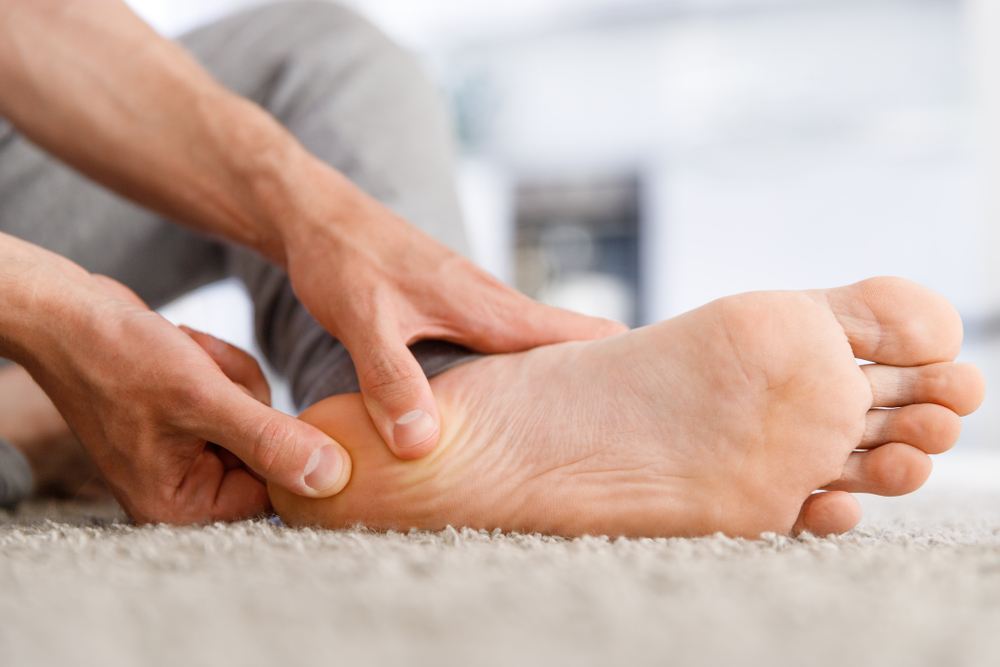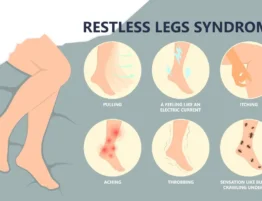
We are frequently asked, what is the most common foot complaint? Without a doubt, plantar fasciitis is at the top of the list. Oftentimes, it is referred to as heel pain, or heel spur pain. The symptoms of plantar fasciitis often occur first thing in the morning, as the pain exists on the bottom of the heel and is irritated with those initial morning steps. You may hobble to the bathroom, or to go make some coffee, and after a few minutes the pain wears off. However, as it becomes more severe, you may notice the pain throughout the day, and it can come on gradually or all at once.
 Plantar fasciitis is seldom caused by trauma. Although it could be caused by you falling on your foot and striking your heel, in most cases, it’s something that just happens and is unpredictable. Foot biomechanics can also play a role.
Plantar fasciitis is seldom caused by trauma. Although it could be caused by you falling on your foot and striking your heel, in most cases, it’s something that just happens and is unpredictable. Foot biomechanics can also play a role.
While plantar fasciitis is a common foot problem, it rarely occurs in your teenage years or early twenties Why is this? One of the ideas is that the fascia loses its elasticity over time. The fascia runs from the ball of the foot to the heel, where it attaches. With every step you take, as the arch flattens, the fascia pulls from its attachment point (aka the heel). When your foot is not bearing weight, the arch is relatively high, but as soon as your bear weight the arch flattens and pulls on the fascia.
This pain from the common foot problem can become very disabling as it can go on for months, or even years in some cases. It is important to note that an x-ray can sometimes show a heel spur, where the fascia attaches to the heel. The old school idea is that this was the source of the pain, however this is seldom the case. If surgery is ever performed to eliminate your plantar fasciitis (using small incisions to partially release the fascia), nothing is done to the spur. Patients have a remarkably high success rate with this form of surgery, proving that it is not the spur. In fact, the spur could have been created by the fascia pulling from your heel.
What Can You Do For Plantar Fasciitis?
Since plantar fasciitis is one of the most common foot problems, it is also the one that has the most treatment options. It can get confusing because everyone, including your shoe salesman, will claim to have the solution.
But the actual treatment solutions for plantar fasciitis are limited. There are many options that can help a bit, as these are referred to as “band-aid approaches”. These band-aid approaches include anti-inflammatories, icing, and stretching. They are fine to try, and in some cases can help a lot, but it’s important to do these at the earliest stages of your heel pain.
You can also try using supports, and if the shoes you wear for walking, hiking or running are worn down, consider replacing them. If these attempts fail, or if you find yourself having to go back to these approaches time and time again, it may be time to seek professional help.
Orthotics
Orthotics are one of the foundational things that a podiatrist will use. Orthotics help hold and support the foot better so that the fascia does not want to pull away from the heel. It is important that the orthotics being made utilizes either a casting technique, or a digital system by taking a non-weight bearing, impression of your foot. This captures the foot in its ideal functional position in order to get more precise control of your foot. Orthotics minimize how much that fascia is pulling from your heel by supporting your bony structure better.
Stem Cell Treatment
Podiatrists traditionally used cortisone injections to treat plantar fasciitis, but at Anderson Podiatry Center, we still do this on occasion, but recommended the consideration of stem cell treatment. It’s been known from recent studies that the fascia is not truly inflamed, but rather it’s tissue is breaking down and in need of repair. So what better way to do this than with stem cells (we typically use placenta cells).
Shockwave Treatment and Laser
Shockwave sends powerful sound waves into the heel area. This traumatizes the heel, but puts your body into a repairative mode that helps repair the fascia. We also use a treatment called MLS laser which helps by improving the functionality of the mitochondria in your cells to repair the fascia.
Surgery
Surgery is done on occasion, but only after conservative measures have failed. It’s typically done with a scope, and we make a small incision on both sides of the heel. Patients can ambulate immediately, but usually have to wear a movable cast for approximately two-four weeks. Success rate for this is quite high.
If your attempts to remedy your heel pain are not working, it may be time to move on to a more aggressive treatment plan. The longer you wait to see a podiatrist, the more time and treatment options you may need to eliminate the pain.









Write a comment: